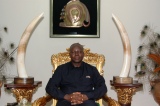| |
H.E. Otumfuo
Osei Tutu II
Kobina
Annan, Jr.
In African communities as well as many others across
the globe, there are kings and queens who by virtue
of birth hold the highest positions in the their
communities’ traditional societies.
In Ghana, Otumfuo Osei Tutu II, King of the Ashanti
Kingdom and the 16th Asantehene to ascend the royal
throne is one such royal.
| |
 |
|
| |
Otumfuo at his
palace |
|
|
Photo:
Kobina Annan, Jr. |
It was not until the end of the 17th century that
the grand Ashanti Kingdom emerged in the central
forest region of Ghana. Osei Tutu I, military leader
and head of the Oyoko clan, founded the Ashanti
kingdom. He obtained the support of other clan
chiefs and using Kumasi as the central base, subdued
surrounding Akan states.
It is imperative that we understand the importance
of this historical movement created by the first
Asantehene. Initially, the Ashanti Kingdom operated
first as a loose network and eventually as a
centralized kingdom with an advanced, highly
specialized bureaucracy, which in turn led to the
Ashanti rule.
Being the first Asantehene (Ashanti king), he was
guided by his adviser the priest Okomfo Anokye. The
relationship between the king and his priest might
not be vastly different from that found in Camelot,
in the fable of King Arthur and Merlin.
As his fame and influence grew, so did the need
to create a powerful kingdom that would unite the
Ashanti’s as a prelude to the unification of all the Akan tribes. In this he was aided by Akomfo Anokye.
The Golden Stool became the embodiment of the
political and military unity of this Akan
confederacy, which made the Ashanti one of the most
historically significant groups in the entire West
African region. To this day, the Golden Stool still
embodies the focal point of an Ashanti unity, the
power of which supports the current occupant of the
stool, Otumfuo Osei Tutu II, the Asantehene.
With the defeat of Denkyira, then the most powerful
kingdom, by Ashanti-speaking forces under Osei Tutu,
the idea of a new united kingdom of Ashanti became a
reality. Okomfo Anokye invited the various Ashanti
chiefs to an important meeting. At this meeting
Okomfo Anokye told the Chiefs that he was about to
command a Stool from Heaven, with the powers given
to him by God. He added that the Stool would rest on
the lap of one of the assembled Chiefs. This ritual
is quite similar to Merlin’s arrangement for the
sword-in-the-stone contest which resulted in Arthur
becoming the King of his kingdom.
The Asantahene, who inherited his position along
matrilineal lines, has numerous chiefs below him
throughout the kingdom who act on his behalf. He
also has many counselors with whom he conferrers
before making decisions.
Otumfuo Osei Tutu II is the youngest of the five
children from Nana Afua Kobi Serwaa Ampem II, the
current Queen Mother of the Ashanti. Born on May 6,
1950 he was given the name Barima Kwaku Dua, but is
known as Otumfuo Osei Tutu II because of his royal
status.
After completing his education in accountancy at the
Institute of Professional Studies at Legon in 1971,
he moved to the United Kingdom to pursue further
professional courses at Kilburn Polytechnic.
On the completion of that part of his studies in UK,
Otumfuo worked with several companies there,
acquiring the managerial and administrative skills
that would later prove useful to him as a modern
ruler. Among the positions he held while in
employment in the UK were as finance officer at a
Food Processing Company, Oxo, in London and later as
personnel administrator at the Manpower Services
Commission.
In 1989, Otumfuo returned to his homeland Ghana to
establish his own company, Transpomech
International, LTD. He is still the executive
director of this company.
Since ascending the stool, Otumfuo Osei Tutu II’s
charismatic style and leadership strengths have won
him admiration from Ghanaians, the Ashanti people,
and foreigners. His vision to help Ghanaians entails
education, and developments in economic and health
institutions. Because of this vision the Osei Tutu
Fund was created to offer assistance to those in
need of prevention of loss of vision caused by
glaucoma. He is the first traditional chief in Ghana
to support this kind of health issue.
As Otumfuo Osei Tutu II’s reputation grows
throughout Ghana, his majestic presence and ability
to interact with a diverse range of individuals and
be effective politically and socially leaves
footprints on the heart of our nation.
Kobina
Annan, Jr, Accra, June 21, 2008
|






